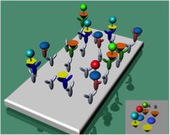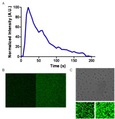Highlight
Developing Sensors for Diagnostics and Monitoring of Clincially Relevant Samples
Achievement/Results
A group of investigators in Chemical Engineering and Chemistry have developed sensors for diagnosis and monitoring of clinically relevant samples. As the move towards the miniaturization of many diagnostic and detection systems continues, the need for increasingly versatile yet sensitive labels for use in these systems also grows. Bioluminescent proteins provide many of the desired characteristics for such labels, including detection at extremely low concentrations, no interference from physiological fluids leading to excellent detection limits, and compatibility with many of the miniaturized systems such as lab-on-a-chip and lab-on-a-CD designs. However, the use of BL proteins has been restricted by the limited multiplexing capabilities.
Bioluminescent proteins typically exhibit a single emission profile and decay kinetics making the simultaneous detection of multiple analytes difficult. Recent progresses in this area include the use of two different luminescent proteins or engineered mutant proteins to achieve resolved signals, and engineered photoproteins differentiated through time resolution, however all of these studies are limited to dual analyte detection only. Herein we have demonstrated that by combining both time and wavelength resolution the multiplexing capabilities of the photoprotein aequorin can be expanded. To that end, aequorin has been employed for the simultaneous detection of three separate analytes in single well, differentiated through the use of three discrete time/wavelength windows. Aequorin, native to the jellyfish Aequorea victoria, emits light at 469 nm with a half-life of ~ 2 s in the presence of Ca2+ and molecular oxygen. Through a combination of site-specific mutations and synthetic coelenterazines “semi-synthetic” aequorin variants have been developed with altered emission profiles and decay kinetics (Figure 1).
In this study, three aequorin mutant proteins were genetically conjugated to three pro-inflammatory cytokines (interleukins 1β, 6, and 8) resulting in aequorin labeled cytokines (Figure 2). These fusion proteins were combined with synthetic coelenterazines resulting in proteins with differing emission maxima and half lives to allow for the simultaneous detection of all three cytokines in a single solution, through the physiologically relevant range. Despite the analytical advantages of bioluminescence and aequorin mentioned above, aequorin has been somewhat limited in labeling and imaging applications outside of calcium dynamics due to the potentially cumbersome conjugation of the protein, the flash type emission kinetics, and extremely slow turnover rate of the bioluminescent reaction. In an effort to overcome these limitations we have genetically altered the photoprotein aequorin to improve not only the analytical potential as a label but also the imaging capabilities. A unique cysteine was incorporated into the Y82F aequorin mutant to allow easy, site specific conjugation of the protein to any molecule of interest through well established procedures.
As a proof of concept, the new aequorin variant, C5Y82F, was used as a label for the acute myeloid leukemia (AML) cell surface antigen CD33 (Figure 3). C5Y82F aequorin was conjugated to an anti-CD33 antibody and showed the ability to detect the important clinical marker, free circulating CD33, down to the attomole levels and as few as 3 AML cells in a microtiter plate system. In addition, when C5Y82F aequorin was combined with the synthetic coelenterazine i the bioluminescence was able to be visualized on an imaging microscope for roughly three minutes and indicate the presence of AML cells (Figure 4). In the future, the C5Y82F aequorin variant can be combined with other aequorin variants for multiplexed diagnostic and imaging applications.
Address Goals
This project focuses using biotinylated proteins to produce sensors or diagnosis and monitoring of clinically relevant samples. It advances knowledge in the area of Bioactive Interfaces and demonstrates how this area of research can be used to develop valuable devices. This project also demonstrated the importance of interdisciplinary research as it could not have been accomplished without chemists and chemical engineers working together to achieve the final goal.









